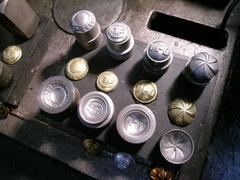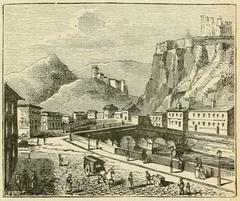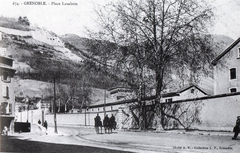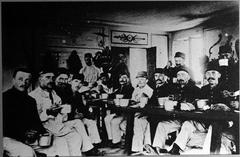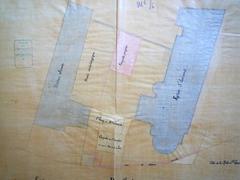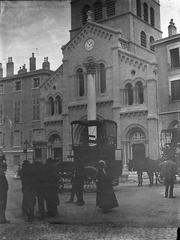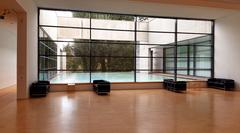École Nationale Supérieure D'Électronique Et De Radioélectricité De Grenoble
Visiting Hours and Tickets for École Nationale Supérieure D’Électronique Et De Radioélectricité De Grenoble (ENSERG) in Grenoble
Date: 04/07/2025
Introduction
The École Nationale Supérieure d’Électronique et de Radioélectricité de Grenoble (ENSERG) played a pivotal role in the development of engineering education and technological innovation in France. Today, its legacy continues as part of Phelma—École Nationale Supérieure de Physique, Électronique, Matériaux—within Grenoble INP, a constituent of Université Grenoble Alpes (UGA). Situated in the innovative MINATEC campus at the foot of the French Alps, this institution remains central to Grenoble’s reputation as a hub of scientific research and advanced industry.
This guide provides a comprehensive overview for visitors interested in exploring ENSERG’s historical significance, current campus life, visiting logistics, and nearby attractions. Whether you are a prospective student, a science enthusiast, or a traveler seeking to experience Grenoble’s scientific and cultural landscape, this resource will help you plan an informative and memorable visit.
Table of Contents
- ENSERG and Phelma: Historical and Academic Significance
- Visitor Information
- Nearby Attractions
- Planning Your Visit: Travel Tips and Best Times
- Frequently Asked Questions (FAQ)
- Conclusion and Additional Resources
- References
ENSERG and Phelma: Historical and Academic Significance
Founded in 1958, ENSERG quickly established itself as a leader in electronics, microelectronics, and radioelectricity. Its foundation aligned with Grenoble’s vision to become a center of scientific and industrial advancement. The school’s rigorous engineering programs trained generations of specialists who went on to shape France’s telecommunications, computing, and micro/nanotechnology industries, often in partnership with major firms and national research agencies (Academia Lab, Grenoble INP - UGA History).
In 2008, ENSERG merged with other top engineering schools to form Phelma, expanding its academic horizons to include advanced materials science and broadening its international reach. Today, Phelma and Grenoble INP continue ENSERG’s tradition of excellence as part of the MINATEC innovation campus—Europe’s leading center for micro and nanotechnologies (PHELMA Website).
Visitor Information
Location and Access
- Address: Phelma Grenoble INP (former ENSERG site), MINATEC, 3 Parvis Louis Néel, CS 50257, Grenoble Cedex 1, France (University Directory).
- Transport:
- By Tram: Tram B (stop: “Cité Internationale”) directly connects the campus to the city center and train station.
- By Train: Grenoble Gare SNCF is a 10–15 minute walk or quick tram ride from campus, with direct trains from Paris, Lyon, and Geneva.
- By Air: Grenoble Alpes-Isère Airport (GNB) is about 40 km away; shuttles and taxis are available (Nomads Travel Guide).
- By Bike: Grenoble is highly bike-friendly, and the Métrovélo bike-sharing system is available (Nomads Travel Guide).
Visiting Hours
- Campus Hours: Monday to Friday, typically 8:30 AM–6:00 PM. Note that these hours apply to the active Phelma campus, which encompasses ENSERG’s legacy.
- General Access: The campus is an active academic and research institution. While the grounds are accessible during working hours, access to buildings, labs, and specialized areas requires prior arrangement.
Entry and Tickets
- Entry: There is no ticketed admission for general campus grounds. Access to specific events, exhibitions, or laboratory visits may require prior registration or invitation.
- Guided Tours: Tours are available primarily for academic, professional, or group visitors and should be booked in advance by contacting Phelma (PHELMA Contact).
- Special Events: Public events such as open days (“Journées Portes Ouvertes”), the annual Fête de la Science, and science fairs are excellent opportunities for visitors to explore the campus and interact with faculty and students (Grenoble INP Events).
Accessibility
- Mobility: The campus features ramps, elevators, and accessible restrooms. Public transportation and campus paths are designed for wheelchair access.
- Special Needs: Visitors with specific accessibility requirements should notify the administration in advance to ensure support.
Photography
- Allowed: Outdoor photography and public areas.
- Restricted: Laboratories and research zones require authorization. Always seek permission before photographing people or sensitive equipment.
Nearby Attractions
Grenoble’s scientific and cultural district offers a wealth of experiences beyond the campus:
- Musée de Grenoble: Renowned for its impressive art collections (The Crazy Tourist).
- Bastille Fortress: Reachable by cable car, offering panoramic views of the city and Alps (Grenoble Tourisme).
- Muséum d’Histoire Naturelle de Grenoble: Showcasing Alpine biodiversity.
- Parc Paul Mistral and Jardin des Dauphins: Ideal for walks and relaxation.
- Vercors and Chartreuse Mountains: Popular for hiking, skiing, and nature excursions (France Voyager).
Planning Your Visit: Travel Tips and Best Times
- Best Seasons: Spring and autumn offer mild weather and beautiful Alpine scenery. Winter is perfect for combining your visit with skiing and mountain activities.
- Accommodation: Options range from budget hotels near campus (Residhome, Ibis Styles) to mid-range and boutique choices (Okko Hotels, Grand Hotel Grenoble) (Hikersbay).
- Dining: On-campus cafeterias, as well as numerous restaurants and cafes nearby, provide a variety of options.
- Language: French is the main language, but English is widely spoken in academic settings. Signage is often bilingual.
- Safety: The campus and city are generally safe. Usual urban precautions apply (Hikersbay).
- Sustainability: Grenoble and the campus promote eco-friendly practices, recycling, and public transportation.
Frequently Asked Questions (FAQ)
Q: Can I visit ENSERG or Phelma without an appointment?
A: General access to campus grounds is possible during working hours, but building entry and lab visits require prior arrangement.
Q: Are there tickets required for entry?
A: No tickets are needed for campus access; specific events or guided tours may require registration.
Q: Are guided tours available?
A: Yes, guided tours for educational or professional groups can be arranged by contacting the administration in advance.
Q: Is the campus wheelchair accessible?
A: Yes, the campus provides full accessibility for visitors with reduced mobility.
Q: When are the best times to visit?
A: Spring and autumn for weather and scenery; October for the “Fête de la Science.”
Q: Where can I find more visitor information?
A: Official websites: Grenoble INP and Phelma Grenoble.
Conclusion and Additional Resources
ENSERG’s legacy, preserved within Phelma Grenoble INP, offers visitors a remarkable window into the evolution of French engineering, research, and innovation. While casual visits are limited due to the campus’s academic nature, arranging a tour or attending public events provides a rich, immersive experience. Pair your visit with a tour of Grenoble’s historical and natural sites for a complete exploration of the region’s scientific and cultural vitality.
For the latest information on tours, events, and campus news, regularly consult the official Grenoble INP and Phelma websites, and follow their social media channels. Downloading the Audiala app can further enhance your visit with guided audio tours and curated content.
References
- ENSERG and Phelma in Grenoble: Visiting Hours, Tours, and Visitor Information for Science and Engineering Enthusiasts (Grenoble INP Website)
- Visiting ENSERG and PHELMA: Exploring Grenoble’s Premier Engineering Schools and Innovation Hub (PHELMA Website)
- Exploring ENSERG Legacy and Campus Visit Information in Grenoble (Academia Lab)
- Visiting ENSERG and Phelma Grenoble INP: Practical Tips and Access Information (University Directory)
- Travel and local tips (Nomads Travel Guide), (Hikersbay), (France Voyager), (The Crazy Tourist), (Grenoble Tourisme), (Try Travel).
